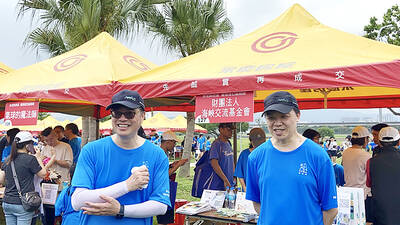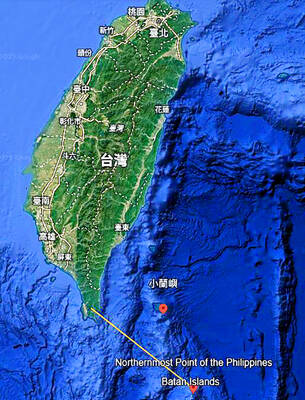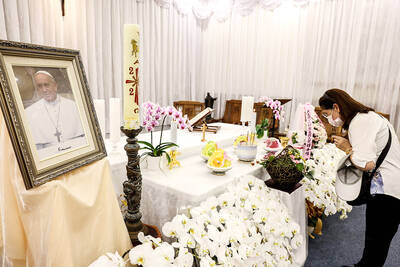Beijing has never given up on the potential of uniting Taiwan with China by force and its national defense funding continues to grow yearly, Minister of National Defense Kao Kuang-chi (高廣圻) said in a report to be submitted to the Legislative Yuan.
Reporting on the development of cross-strait affairs, Kao said the Chinese Communist Party (CCP) has continued to modernize its military as well as reinforce its combat capability against Taiwan by improving its military command structure, replacing outdated equipment and stepping up training for its armed forces.
The report came in light of recent cross-strait talks over the M503 flight path — which runs along the middle of the Taiwan Strait, with feeder routes to China labeled W121, W122 and W123 — arbitrarily announced by China in January. Taiwanese officials said that the path could affect security for flights to Kinmen County and Lienchiang County.
The People’s Liberation Army (PLA) Air Force and Navy have also begun air and sea drills in the western Pacific to familiarize its forces with anti-access/area denial (A2/AD) strategies, Kao said.
All of this is evidence that Beijing has not given up the thought of unification through force, Kao said.
The Ministry of National Defense is monitoring the Taiwan Strait and the actions of the PLA, Kao said, adding that the ministry would also keep apprised of international territorial affairs.
Meanwhile, Chinese Nationalist Party (KMT) Legislator Lin Yu-fang (林郁方) said that at last count, the CCP controlled seven known shoals and islands in the Spratly Islands, known in Taiwan as the Nansha Islands (南沙群島).
The largest of the seven — Fiery Cross Reef (Yongshu Reef, 永暑島) — is at least three times larger than Itu Aba Island (Taiping Island, 太平島), the largest naturally occurring islands in the Spratly group after being made five times larger by landfills, Lin said.
With the island now 2,000m long, it is considered eligible for the construction of an airfield, Lin said.
Though Vietnam has not used landfill methods to enlarge the Sandy Cay (Duncian Shajou, 敦謙沙洲) and Namyit Island (Hongsiou Island, 鴻庥島), 6 and 12 nautical miles (11km to 22km) from Itu Aba Island respectively, there are signs of the Vietnamese government increasing their artillery deployed on both islands, Lin said.
However, the Vietnamese military is reclaiming land and expanding Sin Cowe Island (Jinghong Island 景宏島) — 30 nautical miles from Itu Aba Island — which is now roughly the size of 130 basketball courts, Lin said, adding that there was a possibility that Vietnam would begin constructing piers capable of berthing large ships.
Vietnam is posing a considerable threat to Taiwan’s lone garrison in the South China Sea, Lin said.
Construction of piers on Itu Aba Island is scheduled to be finished by the end of this year and would offer berthing of frigate-class ships of up to 3,000 tonnes, Lin said.
With both the CCP and Vietnam stepping up the scale of their military bases in the region, the need to extend the Itu Aba Island airstrip is becoming more urgent, Lin said, calling on the ministry to begin the extension as soon as the piers have been finished.
Lin also said the ministry should consider moving regular troops onto the island to oversee its defenses. The nation pulled marines from the island and turned over garrison duty to the Coast Guard Administration in 2000.

SECURITY: As China is ‘reshaping’ Hong Kong’s population, Taiwan must raise the eligibility threshold for applications from Hong Kongers, Chiu Chui-cheng said When Hong Kong and Macau citizens apply for residency in Taiwan, it would be under a new category that includes a “national security observation period,” Mainland Affairs Council (MAC) Minister Chiu Chui-cheng (邱垂正) said yesterday. President William Lai (賴清德) on March 13 announced 17 strategies to counter China’s aggression toward Taiwan, including incorporating national security considerations into the review process for residency applications from Hong Kong and Macau citizens. The situation in Hong Kong is constantly changing, Chiu said to media yesterday on the sidelines of the Taipei Technology Run hosted by the Taipei Neihu Technology Park Development Association. With

CARROT AND STICK: While unrelenting in its military threats, China attracted nearly 40,000 Taiwanese to over 400 business events last year Nearly 40,000 Taiwanese last year joined industry events in China, such as conferences and trade fairs, supported by the Chinese government, a study showed yesterday, as Beijing ramps up a charm offensive toward Taipei alongside military pressure. China has long taken a carrot-and-stick approach to Taiwan, threatening it with the prospect of military action while reaching out to those it believes are amenable to Beijing’s point of view. Taiwanese security officials are wary of what they see as Beijing’s influence campaigns to sway public opinion after Taipei and Beijing gradually resumed travel links halted by the COVID-19 pandemic, but the scale of

A US Marine Corps regiment equipped with Naval Strike Missiles (NSM) is set to participate in the upcoming Balikatan 25 exercise in the Luzon Strait, marking the system’s first-ever deployment in the Philippines. US and Philippine officials have separately confirmed that the Navy Marine Expeditionary Ship Interdiction System (NMESIS) — the mobile launch platform for the Naval Strike Missile — would take part in the joint exercise. The missiles are being deployed to “a strategic first island chain chokepoint” in the waters between Taiwan proper and the Philippines, US-based Naval News reported. “The Luzon Strait and Bashi Channel represent a critical access

Pope Francis is be laid to rest on Saturday after lying in state for three days in St Peter’s Basilica, where the faithful are expected to flock to pay their respects to history’s first Latin American pontiff. The cardinals met yesterday in the Vatican’s synod hall to chart the next steps before a conclave begins to choose Francis’ successor, as condolences poured in from around the world. According to current norms, the conclave must begin between May 5 and 10. The cardinals set the funeral for Saturday at 10am in St Peter’s Square, to be celebrated by the dean of the College